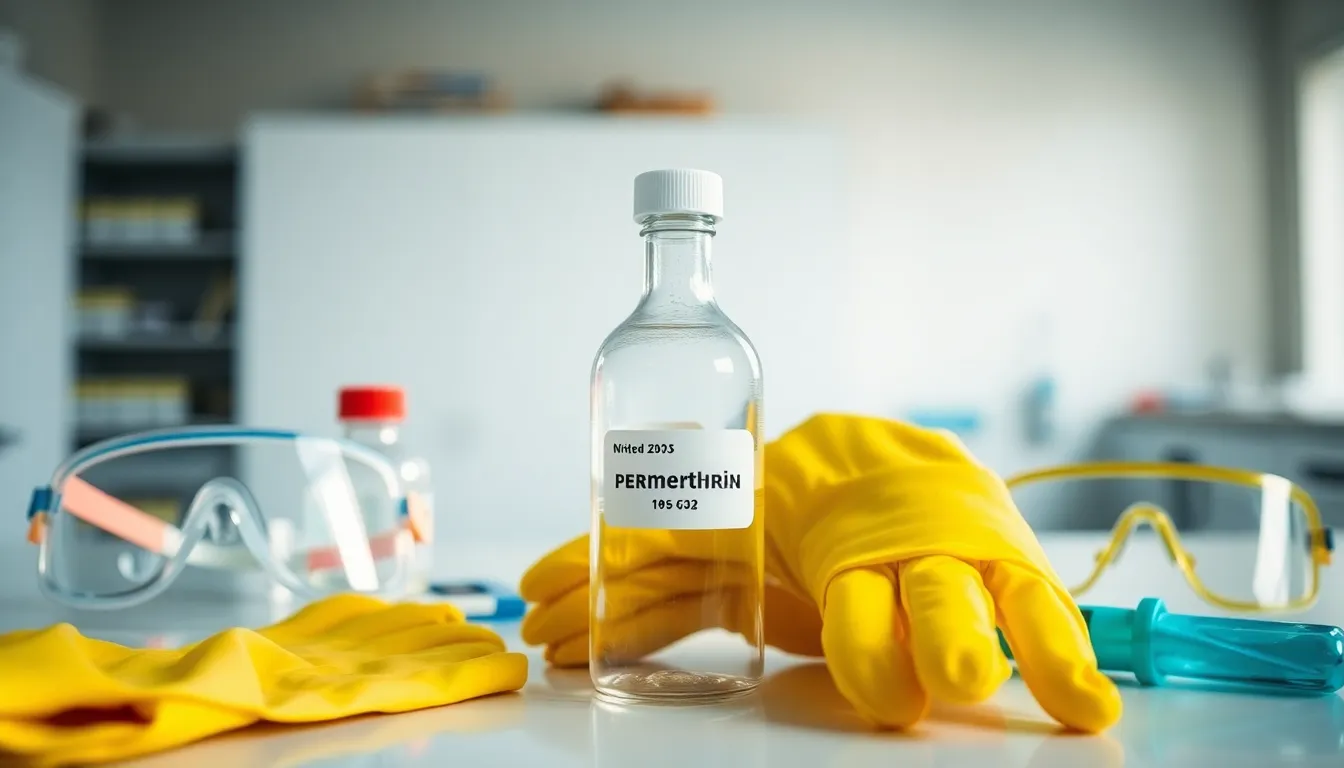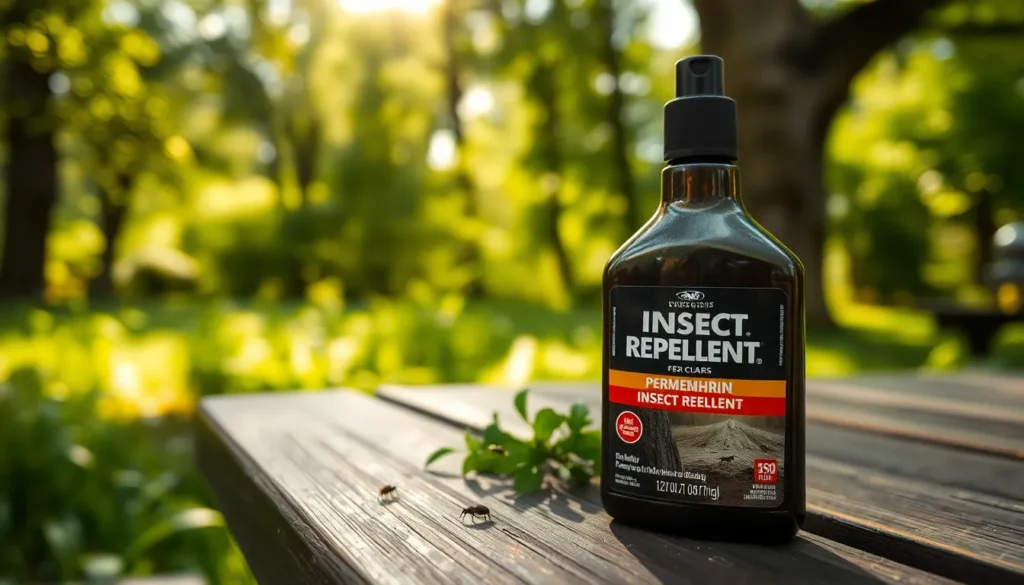Table of Contents
ToggleWhen it comes to keeping pesky bugs at bay, permethrin often steals the spotlight. This powerful insect repellent has earned its reputation for effectively tackling everything from mosquitoes to ticks. But before you douse yourself in this bug-busting elixir, you might wonder: is permethrin toxic to humans?
Overview of Permethrin
Permethrin serves as a widely accepted insect repellent, effectively combating various pests, including mosquitoes and ticks. This synthetic chemical belongs to the pyrethroid class, designed to mimic natural insecticides derived from chrysanthemum flowers. Significant usage includes treatment for clothing, outdoor gear, and bedding, enhancing protection against insect bites.
Its functioning mechanism involves attacking the nervous system of insects, leading to paralysis and death. This method of action raises inquiries about its effects on human health. Safety assessments conducted by agencies like the Environmental Protection Agency (EPA) and the World Health Organization (WHO) deem permethrin safe for human use when applied according to instructions.
Exposure risks occur primarily during application. Symptoms of exposure may include skin irritation, headaches, or dizziness. Prolonged exposure can increase potential health hazards, emphasizing the importance of following usage guidelines.
Permethrin’s efficacy extends to controlling pests in agricultural settings, making it invaluable for farming. Studies demonstrate that it effectively reduces mosquito populations, thus lowering the risk of diseases like West Nile virus and Lyme disease. Understanding its safety profile is crucial, especially for individuals using permethrin-treated products regularly.
Public health organizations recommend those with sensitive skin or underlying health conditions evaluate potential reactions before use. Responsible application remains key to maximizing its benefits while minimizing risks to human health.
Understanding Toxicity

Permethrin’s safety raises important considerations regarding its toxicity. While it is generally regarded as safe when used properly, understanding toxicity is essential for informed application.
Definition of Toxicity
Toxicity refers to the degree to which a substance can cause harm to living organisms. Specific measurement of toxicity often considers factors like dose response and the type of exposure. Permethrin exhibits low toxicity levels for humans but can become harmful under certain conditions. Acute effects may occur with substantial exposure, resulting in symptoms like headaches or skin irritation. Chronic exposure, however, might provoke more serious health issues, necessitating caution and awareness.
Factors Influencing Toxicity
Several factors influence the toxicity of permethrin. Dosage represents a significant determinant; higher concentrations can lead to increased adverse effects. Mode of exposure plays a crucial role as well; dermal contact tends to present lower risks compared to inhalation or ingestion. Individual sensitivity varies; those with skin conditions may experience heightened reactions. Environmental conditions also significantly affect toxicity levels; for instance, humidity can enhance skin absorption. Understanding these factors helps minimize health risks while maximizing the benefits of permethrin use.
Evidence on Permethrin’s Toxicity
Research indicates that permethrin shows minimal toxicity to humans when used as directed. Studies have investigated the effects of human exposure, providing essential insights into safety precautions.
Studies on Human Exposure
Clinical studies highlight the safety profile of permethrin. The EPA has categorized permethrin as a class B2 carcinogen, indicating no significant risk to humans when applied correctly. In trials, occasional skin irritation occurred in sensitive individuals, but serious health concerns remain rare. Furthermore, a review by the WHO found that short-term exposure did not result in severe adverse effects for most people. Regular monitoring and adherence to application instructions play key roles in maintaining safety.
Comparisons with Other Pesticides
When compared to other pesticides, permethrin demonstrates a favorable safety record. Risk assessments show it has lower toxicity than organophosphates, which can pose significant health risks. Insecticides like malathion and chlorpyrifos have been linked with various toxic effects, while permethrin’s targeted approach offers a safer alternative for pest control. Moreover, permethrin’s rapid breakdown in the environment reduces long-term exposure concerns, further solidifying its position as a preferred choice.
Safety Guidelines for Permethrin Use
Permethrin use requires adherence to safety guidelines to minimize health risks. Users benefit from understanding recommended concentrations and protective measures.
Recommended Concentrations
EPA advises using permethrin at concentrations of 0.5% for treating clothing and gear. Concentrations between 0.5% and 1% are suitable for personal protection against insects. Higher concentrations, such as 5%, are appropriate for treating agricultural products. Users should avoid exceeding these limits to prevent increased toxicity risks. Following label instructions ensures safe application and effectiveness in repelling pests. Environmental conditions, such as wind or temperature, may impact efficacy, making it essential to apply permethrin during optimal circumstances.
Protective Measures
Wearing gloves during permethrin application protects the skin from irritation. Clothing should be treated in well-ventilated areas to reduce inhalation risks. After application, it’s important to allow garments to dry completely before wearing them. Users should wash exposed skin thoroughly with soap and water after contact. Storing permethrin products securely out of reach of children prevents accidental exposure. Individuals with sensitive skin or medical conditions must consult healthcare providers for tailored advice. These measures promote safe use and enhance overall protection against insect-related illnesses.
Regulatory Stance on Permethrin
Agencies such as the Environmental Protection Agency (EPA) and the World Health Organization (WHO) support the safe use of permethrin for humans when applied according to the manufacturer’s guidelines. Safety assessments emphasize that risks primarily arise during application, leading to potential symptoms like skin irritation, headaches, or dizziness. Prolonged exposure heightens health hazards, underscoring the importance of adhering to usage instructions.
Recommendations for permethrin focus on specific concentrations. The EPA suggests using permethrin at 0.5% for treating clothing and gear, while higher concentrations may be appropriate for agricultural products. Individuals should follow labeling instructions and apply the product under favorable environmental conditions.
Protective measures are critical during application. Users should wear gloves, apply permethrin in well-ventilated areas, and ensure treated garments dry completely before use. Consulting healthcare providers is advisable for those with sensitive skin or pre-existing medical conditions, enhancing safety and efficacy.
Clinical studies support permethrin’s minimal toxicity when used as instructed. The EPA classifies it as a class B2 carcinogen, indicating no significant risk with proper application. The WHO’s review revealed that short-term exposure rarely causes severe adverse effects for most individuals. Compared to other pesticides, permethrin maintains a favorable safety profile, exhibiting lower toxicity than organophosphates.
Environmental considerations also play a role. Permethrin breaks down rapidly in the environment, further reducing long-term exposure concerns. Understanding these regulatory perspectives on permethrin reinforces its position as a trusted choice for effective pest control and safety.
Permethrin stands out as a reliable insect repellent with a strong safety profile when used correctly. Regulatory bodies like the EPA and WHO have affirmed its minimal toxicity to humans, emphasizing that risks primarily arise during application. Adhering to safety guidelines is essential for maximizing benefits while minimizing potential health risks.
Individuals with sensitive skin or health concerns should take extra precautions and consult healthcare professionals for personalized advice. With its rapid environmental breakdown and lower toxicity compared to other pesticides, permethrin remains a preferred choice for effective pest control. Understanding its safety measures allows users to protect themselves effectively from insect-related diseases without compromising their health.







